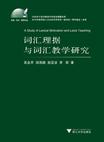词汇理据与词汇教学研究
出版时间:2011-8 出版社:浙江大学出版社 作者:吴会芹 等著 页数:206
内容概要
吴会芹、胡海鹏、施亚波、李辉所著的《词汇理据与词汇教学研究》研究的范围仅限于英语新词的语义理据而非原始词汇或初创词汇的语义理据,这就缩小了话题的范围,为研究的深人提供了便利。作者认为词汇的理据原则和任意性原则共存,它们都是语言的本质属性。论文分析合理,详略得当,具有一定的深度,为语言学习者提供了可以遵循的构词原则,具有理论指导价值。
作者简介
胡海鹏
浙江大学宁波理工学院讲师,硕士研究方向:话语分析和应用语言学研究。主持教育部项目1项(项目号10YIC740039),主持浙江省社科联以及宁波市教育规划项目各1项、在《现代外语》、《当代语言学》、Language
in Society(SSCI)等国内外期刊上发表论文20余篇。 施亚波
浙江大学宁波理工学院讲师,硕士研究方向:话语分析和应用语言学研究。李辉
浙江大学宁波理工学院讲师,硕士研究生研究方向:心理语言学。
书籍目录
Chapter One Introduction
1.1 Brief Introduction to Motivation
1.2 Theoretical Significance of This Study
1.3 Definition of Motivation
1.4 Classification of Motivation
1.5 Conceptual Characteristics of Motivation
1.6 Theoretical Framework of This Study
Chapter Two Motivation-Arbitrariness and Iconicity
2.1 Arbitrariness and Motivation
2.1.1 Conceptual Connotation of Arbitrariness and Motivation
2.1.2 Relationship between Arbitrariness and Motivation
2.1.3 Summary
2.2 Our Opinion
Chapter Three Phonological Motivations of English Lexis
3.1 Onomatopoeia Motivation
3.2 Phonaestheme Motivation
3.3 Reduplication Motivation
3.4 Phonological Shifting Motivation
3.5 The Change of Phonemes Motivation
3.6 Summary
Chapter Four Morphological Motivations of New English Lexis
4.1 Pictographic Motivation
4.1.1 Pictographic Capital Letter and a Word
4.1.2 The Mixture of Pictograph and Meaning
4.1.3 Initial Pictographs
4.1.4 Recessive Pictographs
4.2 Word-formation Motivation
4.2.1 Mot xvations in Compounding
4.2.2 Motivations in Derivation
4.2.3 Motivations in Abbreviation
4.2.4 Motivations in Back-formation
4.2.5 Motivanons in Borrowing
4.2.6 Motivations in Coinage
4.2.7 Motivations in Some Letter Groups
4.3 Summary
Chapter Five Semantic Motivations of New English Lexis
5.1 Political Motivation
5.1.1 Statesman Motivation
5.1.2 Scandal Motivation
5.1.3 Political Event Motivation
5.2 Social Problem Motivation
5.3 Environmental Motivation
5.4 New Lifestyle Motivation
5.4.1 Health Motivation
5.4.2 Leisure and Entertainment Motivation
5.5 New Product Motivation
5.6 Scientific and Technological Motivation
5.7 New Information Motivation
5.8 Summary
Chapter Six Psychological Motivations of New English Lexis
6.1 Fashion Pursuing Tendencies of Mind
6.2 Elegance Seeking Tendencies of Mind
6.3 Diversity Requiring Tendencies of Mind
6.4 Summary
Chapter Seven Etymological Motivations of New English Lexis
7.1 Etymology and Motivation
7.2 Motivatton of Words from Historical Events
7.3 Motivatlon of Words from Culture and Customs
7.4 Motivatlon of Words from Literature
7.5 Motivations of Words from Greek Gods
7.6 Motivatlons of Words from the Bible
7.7 Motivatxons of Words from Names of People and Places
7.8 Motivations of Borrowing Words
7.9 Summary
Chapter Eight The L2 Mental Lexicon and Lexis Acquisition
8.1 The Notion of Mental Lexicon
8.2 The Internal Structure of the Lexical Entries
8.3 The Notion of Word Association(WA)Tests
8.4 Traditional Classifications of Association Responses
8.5 Organization of L1 Mental Lexicon
8.5.1 Phonological Network VS.Semantic Network
8.5.2 The Hierarchical Network Model
8.5.3 The Spreading Activation Model
8.5.4 The Extended Network Model
8.6 WA Tests in L2 Research
8.7 Organization of L2 Mental Lexicon
8.7.1 Phonological View
8.7.2 Semantic View
8.7.3 Syntactic View
8.8 Limitations of the Previous Researches
8.9 Experimental Research
8.9.1 Hypothesis
8.9.2 Participants
8.9.3 Materials
8.9.4 Classifications of Association Responses
8.9.5 Procedures
8.9.6 Results
8.9.7 Discussion
8.10 Implications for L2 Vocabulary Teaching
8.11 Conclusion
Appendix
Chapter Nine Lexis Acquisition in Multimedia Environment
9.1 Introduction to the Application of Vocabulary Motivation
9.2 Vocabulary Learning with CALL and CALT
9.3 Psychological and Multimedia Hardware and Software Foundation
for Vocabulary Learning
9.3.1 Psychological Foundation
9.3.2 M1lltimedia HardWare and Software F011ndation
9.4 Vocabulary Learning Strategies in Multimedia Environment with
Application of Vocabulary Motivation
9.4.1 CALT for VocabularyS Pronunciation,Morphology and
Semantics
9.4.2 Context
9.4.3 Vocabulary Game
9.5 Computational Application of Vocabulary Acquisition in
Multimedia Environment.
9.5.1 Concordance as the Basic Technology in Corpus Linguistics
9.5.2 Vocabulary Acquisition with Concordance
9.5.3 Acquisition of the Word hand by Concordance
9.5.4 Synonyms Acquisition with Concordance
9.5.5 Vocabulary Collocations
9.6 Applications and Implications for Vocabulary Acquisition
Teaching
Chapter Ten Conclusion。 10.1 On Motivation
10.1.1 On Motivations of English Lexis
10.1.2 On Phonological Motivations of New English Lexis
10.1.3 On Morphological Motivations of New English Lexis
10.1.4 On Semantic Motivations of New English Lexis
10.1.5 On Psychological Motivations of English Lexis
10.1.6 On Etymological Motivations of English Lexis
10.1.7 On L2 Mental Lexicon and Lexis Acquisition
10.1.8 On Lexical Motivations and Computer assisted Lexis
Acquisition
10.2 Limitations of the Study
附录1:词典类文献汇编
附录2:英语词汇学类文献汇编
附录3:语言符号任意性、理据性研究类文献汇编
附录4:词源学类文献汇编
附录5:二语心理词汇与词汇习得文献汇编
附录6:计算机辅助语言教学类参考文献汇编
Acknowledgement
图书封面
评论、评分、阅读与下载
